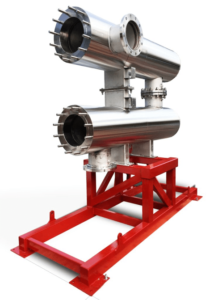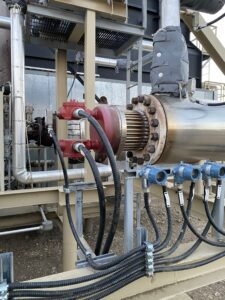Blog Search Results
 Interest in alternative energies in the United States is growing at an exponential rate, as the search for alternative and cleaner fuel sources becomes more challenging. The use of biofuel has been exceptionally popular in Brazil where up to 50 percent of the country’s population use this as an alternative to traditional diesel fuel. Biodiesel is made from vegetable and animal fat based derivatives in places like North Dakota and is created through chemical reactions between lipids (vegetable or animal based oil fat) with an alcohol. Biodiesel is now very popular in North America and around the world as diesel engines are modified to accept it when blended with petro diesel or alone as an alternative fuel source. A major manufacturer of biodiesel located in Oklahoma contacted Wattco with a problem. The biodiesel, which traditionally used immersion heaters to preheat it, had caustic characteristics and was causing the elements to fail at an unacceptable high frequency rate. Because of this, production was down often and the company was unable to meet their obligations with their customers.
Interest in alternative energies in the United States is growing at an exponential rate, as the search for alternative and cleaner fuel sources becomes more challenging. The use of biofuel has been exceptionally popular in Brazil where up to 50 percent of the country’s population use this as an alternative to traditional diesel fuel. Biodiesel is made from vegetable and animal fat based derivatives in places like North Dakota and is created through chemical reactions between lipids (vegetable or animal based oil fat) with an alcohol. Biodiesel is now very popular in North America and around the world as diesel engines are modified to accept it when blended with petro diesel or alone as an alternative fuel source. A major manufacturer of biodiesel located in Oklahoma contacted Wattco with a problem. The biodiesel, which traditionally used immersion heaters to preheat it, had caustic characteristics and was causing the elements to fail at an unacceptable high frequency rate. Because of this, production was down often and the company was unable to meet their obligations with their customers.Solution
The situation was carefully analyzed and researched using samples of the caustic biodiesel that went for lab analysis. The results were conclusive. The concentration of the caustic biodiesel solution was excessive for the heater that was specified. As a result, corrosion settled in and caused the industrial heater to fail. Wattco reengineered the immersion heater with several modifications, notably:
1) The watt density was reduced to 25 Watts per square inch to accommodate the high caustic concentration.
2) The original industrial heating solution had a steel sheath. Wattco substituted it for stainless steel 316 that has more resistive qualities for harsh environments
3) Wattco also allowed for a better flow within the heater by separating the individual haripins and adding a center pipe and baffles. This would help prevent buildup on individual elements and help provide a longer life of the heater.
4) Wattco also used a thicker sheath wall thickness (.035 inch) for better structural integrity of the elements.
Benefits
· A lower watt density increases the life of the heater element
· A better quality sheath material offers better resistance to corrosive elements
· Maintenance is low as the elements last longer
· Production downtime problem has been addressed leaving the company to be productive.
Get a quote on an immersion heater today! WATTCO also manufactures other industrial heating products such as pipe heaters, circulation heaters and control panels. Visit the Our Products page for more information.
 Biodiesel has attracted lots of attention as a viable alternative to fossil fuels. There’s a wide range of potential uses for biodiesel, but processing it into a usable form remains a challenge. This post will examine how we may use biodiesel in the near future and the heating methods and equipment needed to make it feasible.
Biodiesel has attracted lots of attention as a viable alternative to fossil fuels. There’s a wide range of potential uses for biodiesel, but processing it into a usable form remains a challenge. This post will examine how we may use biodiesel in the near future and the heating methods and equipment needed to make it feasible.
Applications of biodiesel
“Biodiesel” refers to any biofuel that can replace traditional diesel as a fuel source. Biofuels are usually the byproducts of animal fats or vegetable oil compounds, which gain combustible properties when processed. Unlike traditional fossil fuels, they emit significantly fewer emissions, hence why there’s widespread interest to use them as fuel sources. With that said, there’s a varied spectrum of applications that biodiesel can serve.
Uses of biodiesel
- Heating oils: Biofuel use for comfort heating has grown significantly, yet it has always been a staple. A classic example is using wood for wood-burning stoves. However, biodiesel can be used as a heating oil that burns clean, reducing the emission of harmful gases like carbon monoxide.
- Electricity generation: Biofuels can produce electricity through direct combustion, usually in a high-pressure steam system that can rotate fans. However, with biofuels, the emissions are far lower.
- Transportation fuel: The transportation sector—cars, trucks, ships, airplanes, trains, and more—are responsible for the majority of emissions. Biodiesels produce significantly fewer emissions than regular diesel, making these vehicles less polluting.
- Oil spill cleanups: It may seem like fighting fire with fire, but using biodiesel can help with the cleanup of oil spills. These fuels contain compounds known as methyl esters, which act as solvents since they reduce the viscosity of crude oil.
Of course, the uses of biofuels surpass these four examples. It’s conceivably possible to replace any fuel source with them, provided they’re properly formulated and heated using the right methods.
Why biodiesel is promising
The benefits of biofuels are holistic, presenting benefits on a global, local, and personal scale. That comes from the fact they’re derived from organic materials that don’t naturally release harmful emissions when burned.
Reasons to use biofuels for industrial applications
- Environmentally friendly: Biodiesel is much “cleaner” than petroleum diesel. For example, in one study, using a particular blend of biodiesel lowered CO2 emissions by 74 percent. Of course, reduced emissions of greenhouse gases translate to fewer effects on our global climate.
- Positive effect on human health and safety: Air pollution, much of which comes from petroleum-based fuels, is linked to rising rates of cancer, cardiovascular, respiratory, and infectious diseases. An industrial sector relying more on biofuels will produce fewer emissions, eventually contributing to safer, healthier air.
- Energy-secure: Since biofuels are largely derived from organic matter, massive quantities can be sourced. This makes them a highly renewable resource.
Challenges of biodiesel
The production and use of biofuels don’t come without challenges. Although the industrial use of biofuels has increased sharply over the years, there are still some constraints that make wider adoption of these fuels difficult.
Reasons biofuel adoption is still a challenge
- Expensive to produce: The production costs of biofuels remain high. This is one of the main reasons why the industrial sector has yet to adopt it as a fuel for the industrial applications it could serve.
- Monoculture: Biofuel sourcing may benefit significantly from monoculture, which refers to growing one crop heavily instead of a rotation of crops. However, this practice can have serious drawbacks for the environment since monoculture can attract destructive pests and increase the risk of total losses for farmers.
- Food and water shortages: Sourcing biofuels from regions where water or certain crops are scarce can further exacerbate a low supply. That is a major concern for low-income and impoverished communities that are already struggling to obtain adequate food and safe drinking water.
Heating biodiesel with Wattco heaters
Another challenge associated with biofuel usage is finding heaters that can burn them for efficient heating. The chemical composition and thermodynamic properties of biofuels can make them too harsh for a heater (assuming the wrong heater or heating settings are used).
For example, one North American producer of biofuels found their immersion heaters would frequently fail when heating biodiesel. Lab analysis showed that the issue stemmed from the fuel’s caustic properties, which were excessive for the heater.
However, we made some alterations to their immersion heaters, such as lowering the watt density and adding a thicker, stainless steel sheath. That enabled them to heat biofuels with a far lower failure rate.
Lessons to learn
A key takeaway from this example is heating biodiesel doesn’t have to be an additional challenge. It’s a matter of analyzing the fuel you intend to use to understand its properties and then adjusting your heater to heat it optimally.
Here at Wattco, we build custom heaters that will heat a biofuel to match its thermal properties so that neither the fuel nor the heater is damaged. We may do this using various methods, including the ones mentioned above such as adjusting wattages and sheath materials. Of course, certain heaters may be more suitable for biofuel heating, and we make recommendations for those as well.
Get a quote for your biofuel-friendly heater today. Our representatives will help you find the exact setup needed for your industrial needs.
The energy sector currently has one of the largest carbon footprints on Earth, which is why governments worldwide want to “decarbonize” it. Industrial heating plays a significant role in releasing emissions but can also contribute to lower emissions if used appropriately. There are some approaches to heating and heater types that can facilitate reduced carbon impacts.
The push to decarbonize the energy sector
 The industrial sector accounts for 30 percent of energy-based carbon emissions in the United States. These levels reached a new peak in 2021, measuring 36.3 gigatonnes(Gt). That measurement represented a 6 percent (2.1 Gt) increase from 2020 when emissions had declined by 5.2 percent due to the COVID-19 pandemic lockdowns. However, the reopening of industries brought back a resurgence of carbon emissions in 2021, surpassing records set in 2010 for the largest single-year increase.
The industrial sector accounts for 30 percent of energy-based carbon emissions in the United States. These levels reached a new peak in 2021, measuring 36.3 gigatonnes(Gt). That measurement represented a 6 percent (2.1 Gt) increase from 2020 when emissions had declined by 5.2 percent due to the COVID-19 pandemic lockdowns. However, the reopening of industries brought back a resurgence of carbon emissions in 2021, surpassing records set in 2010 for the largest single-year increase.
Certain subsets of the energy sector are known for being major polluters. They include:
- Chemicals — Responsible for 20 percent of industrial emissions
- Refining — Responsible for 17 percent of industrial emissions
- Iron and steel — Responsible for 7 percent of industrial emissions
- Food and beverage —Responsible for 6 percent of industrial emissions
- Cement and lime — Responsible for 2 percent of industrial emissions
The likelihood is that these trends will continue without intervention, hence why government agencies are adamant about decarbonization. The overall goal? Achieve net zero emissions—a balance of removing the same amount of emissions industries release. How?
Methods of heating decarbonization
Decarbonization refers to multiple processes, both practical and theoretical. Methods range from choosing greener fuels to recycling waste material, but maximizing heating processes has been identified as a vital step for industrial decarbonization.
Heating is a significant stage of many industrial processes, and, by extension, may contribute to carbon emissions. They can do so depending on the fuels used to power them and the energy used to keep them running. Therefore, decarbonizing the energy sector in terms of heating means three things:
1) Adopting new or less polluting heating methods
2) Making current heating methods more efficient
3) Using “greener” fuel sources for heating.
For many operations, it may be necessary to use two or all three methods to reduce carbon emissions.
Industrial electrification of heat
Fossil fuels have long been a staple energy source for heaters, but electricity can replace traditional fuels in many applications. The obvious advantage of electricity is its low carbon impact, not to mention it is renewable.
Electrification can take various forms. First off, there are the heating methods—induction and radiant heating being two feasible methods of electrified heat. That said, specific heaters would need to be used, such as radiant heaters or electric immersion heaters. Regardless of the method, these heaters use their heating mechanisms as a heat source, transferring almost 100 percent of the heat generated to their target medium.
Ultimately, the purpose of electrified heating is to replace gas and fuels that are significant pollutants. Here at Wattco, we offer pre-constructed and custom heaters, including radiant heaters and electric immersion heaters that can replace fossil-fuel solutions.
Maximizing the efficiency of process heating
Process heating systems have been identified as contributors to a higher carbon footprint. They generate significant waste heat, often made worse by a lack of recapture systems. Where the climate is a factor, such as in colder regions, a lack of insulation and improper placement of process heaters can contribute to heat loss. That invariably leads to more energy consumption (and pollution) to compensate for that heat loss.
Maximizing the efficiency of process heating has been identified as a method to help reduce carbon footprints. That would mean electrifying the heating mechanisms in process heaters and installation materials that minimize heat loss. It may also entail using more efficient heat exchangers and sheath materials to ensure greater heat transfer to a target medium.
How we maximize process heating efficiency
We’ve discussed a six-step process before that helps maximize the efficiency of process systems. Two of the steps we recommend to increase efficiency are minimizing the volume of exhaust gases emitted by process units and insulating the heating system. To minimize gas volume, we recommend techniques, such as fortifying air used for combustion with oxygen. To insulate your system, we suggest using a material with adequate thickness for your given application and the heating system itself.
We can build circulation heaters (which often facilitate process heating) using materials and configurations that maximize heating efficiency. We design these heaters based on precise calculations that incorporate the needs of your industrial application, but, also, its output of energy and pollutants.
Use of low-carbon fuel sources
 The use of green energy sources has fuelled debates in the energy sector for decades now, despite gaining popularity in North America and Europe. There are challenges that have made widespread adoption of these fuels difficult, but they’re nonetheless seen as effective replacements for fossil fuels. The main advantage of these fuels is they’re naturally low-carbon solutions and burn clean, with little impact on air, water, and soil quality.
The use of green energy sources has fuelled debates in the energy sector for decades now, despite gaining popularity in North America and Europe. There are challenges that have made widespread adoption of these fuels difficult, but they’re nonetheless seen as effective replacements for fossil fuels. The main advantage of these fuels is they’re naturally low-carbon solutions and burn clean, with little impact on air, water, and soil quality.
They include the likes of:
- Biofuels—organic plant, liquid, and waste materials.
- Hydrogen—including hydrogen feedstocks and variants
- Solar power—using the sun as a heating source
Using these fuels to power large-scale heating processes would mean replacing fossil fuels, which would invariably reduce harmful emissions. But, as was mentioned above, implementing biofuels can be a challenge.
For example, one American biodiesel manufacturer found that the use of this fuel caused their immersion heater to fail at a high rate of frequency due to its caustic composition. This is typical of biofuels and a potential issue for immersion heaters.
Lab analysis revealed that the biodiesel blend exceeded the limits of the heater. By increasing the watt density and replacing the heater’s sheath material, we were able to mitigate the heater’s failures.
Why does that matter?
It’s an example of how biofuels, a somewhat challenging fuel to use, can be processed to help facilitate the reduction of carbon emissions. At Wattco, our design calculations allow us to build heaters that can handle biofuels to prevent failure. That, in turn, allows you to safely use biofuels as an eco-friendly energy source.
Decarbonized heating is within your reach
Decarbonizing an industrial process may seem daunting, especially for businesses that have limited resources. However, many of the steps mentioned here for reducing carbon emissions require planning and careful design, not necessarily expensive equipment.
We can help you jumpstart the process by understanding the heating requirements for your applications, and then building heaters that can facilitate them. Among those considerations, are how we can maximize the efficiency of your heaters, or allow them to use green fuel sources in a cost-effective fashion.
Get a quote for your energy-friendly industrial heater today. Our representatives will help you find the exact setup needed for your industrial needs.
Alternative and environmentally conscious energy sources are a growth industry. And that’s not just limited to Tesla’s and solar panel roof tiles. One of the biggest areas of growth in the energy sector is in biodiesel manufacturing.
 In part, this is helped in the USA by a 2017 bill to modify the biodiesel tax credit. The bill provides a $1-per-gallon production credit for biodiesel produced in the USA. With the tax credit slated for 3 more years, there is no expectation of a slow in production over that time.
In part, this is helped in the USA by a 2017 bill to modify the biodiesel tax credit. The bill provides a $1-per-gallon production credit for biodiesel produced in the USA. With the tax credit slated for 3 more years, there is no expectation of a slow in production over that time.
This will help meet the increasing national and international need for diesel alternatives. In Brazil, for instance, half the population uses biodiesel.
The production of biodiesel comes with it’s own set of challenges. These require the right equipment for an efficient and cost-effective process. We discuss the role of circulation heaters in biodiesel manufacturing. And how to pick the heater which best suits your needs.
The role of circulation heaters for biodiesel production
Biodiesel is created through chemical reactions between lipids – from vegetables or animal fats – and alcohol. The pressurized liquid needs to be kept circulating with a consistent temperature. This maintains the appropriate viscosity. For this purpose, circulation heaters are ideal.
The best choice for preheating biofuels is a circulation heater. They offer direct immersion in the fluid, for fast and efficient heating. Also, you can add thermocouple sensors to prevent overheating.
In addition to preheating biodiesel fuel oil, circulation heaters help with:
- Increasing temperature
- Maintaining pumping viscosity
- Closed loop heat transfer systems
- Freeze production
Challenges of heating biodiesels
Preheating biodiesel comes with its own specific challenges. Biodiesel has greater caustic characteristics than traditional fuel sources. As a result, the equipment has a much higher failure rate. That means more frequent replacement, more maintenance, and lost/damaged product.
The caustic nature of the medium leads to premature rusting and/or deterioration of equipment. This includes the steel sheath of the circulation heater.
As well, the caustic elements make maintaining flow for biodiesel more challenging than other mediums. This can lead to a buildup on top of elements. Which results in shorter lifespans for circulation heaters.
Addressing the challenges of preheating biodiesel
Wattco has success managing the challenges of heating biodiesel. This was accomplished using lab work and expert experience to help a biodiesel manufacturer in Oklahoma. Wattco analyzed the biodiesel, and identified as the source of corrosion causing the failure of industrial heaters. With this knowledge, Wattco was able to redesign their electric circulation heater to address this specific challenge.
Circulation heater materials for biodiesel heating
The first problem addressed was the corrosion of circulation heater elements. Altering the medium was not an option, so they focused on changing the heater materials.
The original construction used a steel sheath. This was replaced with a stainless steel 316 sheath. This type of steel is more resistant to corrosive elements. As a result damage was reduced so the need for maintenance and repair was also reduced.
The thickness of the sheath wall was also increased. This improves the structural integrity and minimizes the risk of failure. The elements now last longer. This reduces overall biodiesel manufacturing costs and preventing stoppages in production.
Biodiesel heating watt density
The caustic nature of biodiesel also requires an adjustment in watt density. Vegetable oils can tolerate high sheath watt densities. But biodiesel can damage equipment if the watt density is too high. Extreme watt densities can cause the medium to carbonize or overheat. Resulting in damage to the equipment or solution.
By reducing the watt density to 25 Watts per inch2 the life expectancy of the circulation heater is increased.
Increasing circulation heater flow in biodiesel applications
To improve circulation we changed the layout of the heating elements. Hairpins were separated and a centre pipe and baffles were added. The result was a better flow that prevents a buildup on the elements.
This improves flow rate and extends the lifespan of the circulation heater.
Benefits of electric circulation heaters in the biodiesel industry
Electric circulation heaters are the preferred method of heating biofuels. They offer flexibility and customizability in construction, so they address the specific needs of the medium. For example, choosing stainless steel 316 sheaths when heating a caustic solution. As well they offer:
- Efficient heat transfer
- Lower operational costs than fossil fuel powered heaters
- Longer lifespans than fossil fuel powered heaters
- High pressure ratings (up to 25000 PSI)
- Explosion proof housings
- A selection of housing options
- A number of available thermo sensors and controllers
Picking a circulation heater for biodiesel applications
For biodiesel, there are two options for circulation heater – flange or screw plug. Circulation flange heaters are easy to install and come in any configuration required. They are safe, stable, durable, and highly efficient. They heat large volumes and can reach temperatures as high as 1,200 degrees.
The lower Watt density ideal for biodiesel manufacturing can make screw plug circulation heaters a great choice. These heaters screw directly into the tank and have a high degree of control. They are best for smaller applications.
Every application is a little different with variations such as size, climate, and medium. A Wattco representative can help you determine the best circulation heater for you. Contact us today to request a quote or more information.
Circulation heaters are one of the most energy efficient and ready-made means of installing electric heating elements with minimal amount of labor and time. The task of heating liquid is accomplished by combining vessel, heating elements, terminal enclosure, outlet and inlet connections, insulation and mounting brackets.
They are designed with ANSI flange heater or NPT screw plug assemblies with pressure tanks (vessels) in order to heat liquids, air or gases for performing different projects. They are either ideal for side-arm or in-line operations because they have direct fluids held in a container with high quality heating elements to provide even heat distribution and fast response. These immersion heaters are provided with thermocouple sensors that control the temperature and keep the heater safe from overheating. Circulation heaters are especially designed for:
- Water heating
- Heat transfer
- Freeze protection
- Gas heating
- Stea air
- Fuel oil heating
- And many more
Use of Circulation Heating in the Biodiesel Industry
These heaters are normally used in biodiesel industry where companies need to heat the circulating, pressurized liquid. A screw plug immersion heater or a flanged heater is immersed into a pressure vessel, which is called pipe body. This vessel releases its heat into the fluid thus increasing its temperature to the desired level. This approach is really helpful in enhancing the performance of normal immersion heaters. Most of the circulation heater manufacturers have also added different types of thermostats to enable companies easily manage their projects without overheating their equipments.
Circulation heaters have proved to be ideal for biodiesel industry, where they are capable of pumping viscosity, pre-heating fuel oil, increasing temperature of the medium and for closed loop heat transfer systems. They have standard ratings from .5 kilowatt to 565 kilowatt that work in different sheath materials, pressure ratings, watt densities and chamber materials. Picking the right circulation heater for biodiesel manufacturers is critical for efficiency. Companies in densely populated areas such as Illinois and Indiana use these immersion heaters to address viscosity issues.
Benefits for Biodiesel Heating
 Since circulation heaters are highly efficient and compact equipments, they can be ideally used in natural or forced circulation system to heat flowing liquids or gases. Their installation is also simple as it only requires some basic piping and wiring connection knowledge. These immersion heaters have the following benefits for biodiesel industry:
Since circulation heaters are highly efficient and compact equipments, they can be ideally used in natural or forced circulation system to heat flowing liquids or gases. Their installation is also simple as it only requires some basic piping and wiring connection knowledge. These immersion heaters have the following benefits for biodiesel industry:
- Pressure ratings up to 2500 PSI
- ANSI Class 150 or ANSI Standard NPT connections
- Highly efficient in heat transfer
- Heater can be flanged or screw plug
- Constructed with stainless steel and has ASME or Canadian Vessel Registration i.e. CRN approved
- Different housing options- like NEMA 1, NEMA 4, NEMA 4X, NEMA 7 (Explosion Proof)
- Explosion proof
- Idea for chemicals, corrosive solutions, steam, oils, gases
Since biodiesel industry is a huge place for using circulation heaters, companies find them worthy when it comes to the following procedures:
Heat Transfer Oils
Circulation heaters are used as closed loop heat transfer systems, molding platens and dies for heat sensitive materials
Fuel Oil Heating
They are capable of pre-heating fuel oil for burners and pumping viscosity.
Water
Circulation heaters can be easily used for rinsing and dishwashing, process water, hot water storage tanks and jacketed kettles
Steam, Gases, Air
Biodiesel companies use circulation heaters to increase temperature of gases, superheating steam and process air.


